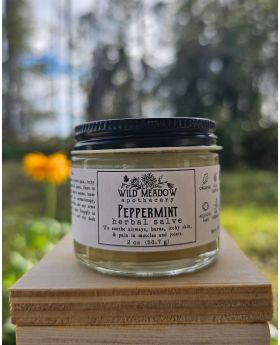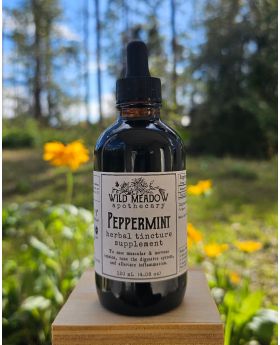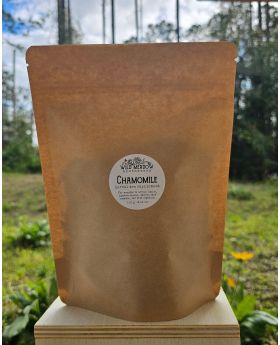Organic
Pure organic ingredients that are completely earth-friendly.
Wildcrafted
Ethically wild harvested plants from their natural habitats.
Non-GMO
All ingredients are non-GMO (not genetically modified).
Kosher
Herbs are Kosher and everything is made with plant-based ingredients.
Vegan
We use plant-based and cruelty-free ingredients and strive to be Earth-friendly.
Gluten-Free
Ingredients do not contain gluten.
Eco-Friendly
Everything is handmade. We use minimal product packaging and large quantities for less waste.
Cruelty-Free
We do not test on animals, nor contribute to the testing of animals.
Lab-Tested
Our herbs are lab-tested by a third-party laboratory to maintain quality and purity.
Good Manufacturing Practices
We follow the current good manufacturing practices according to law.
Peppermint provides many stimulating properties to enliven whole body activity, including digestive, circulatory, immune, and respiratory responses. It has a highly penetrating camphorescent aroma, a cooling sensation alleviating aches and pain, a soothing action on the digestive system, and a stimulating action by encouraging increased blood flow and circulation. This herb can ease muscle spasms, cramps, headache, sore muscles, and joint pain, and alleviate inflammation from injury, digestive distress, sickness, headache, and rheumatism. The herb can enliven the circulatory system, ease throbbing headache, and ameliorate fever. As a digestive therapy, it can be therapeutically taken before or after eating for inducing optimal digestion, easing bloating, clearing gas, and augmenting treatment of irritable bowel syndrome (IBS), inflammatory bowel disease (IBD), Crohn's disease, ulcerative colitis, and other digestive disorders.
Suggested Use
To prepare herbal tea, bring water to a gentle boil – light simmer of small bubbles. Remove the water from the heat. After the simmering settles, the water should be a good temperature to add herbs and begin brewing (205°F / 96°C), but not too hot like a rapid boil (212°F / 100°C). Brew for 10 minutes in a covered teapot, loose-lidded cup, or teacup with a saucer covering tea for maximum herbal potency and retention. Best served fresh. Can store in fridge for 2 to 3 days for highest potency. Teas have a stable shelf life and are packaged in a resealable air-tight bag. They should be stored in a cool dry dark location.
Brew 2 teaspoons (1 gram) herbal tea in 6 to 8 ounces (175-235 mL) water. Take 1-5 g per day, as needed. For children under 12 years but older than 2 years, brew 1 teaspoon (1⁄2 g) herbal tea in 6 ounces (175 mL) water, and take 1⁄2-3 g per day, as needed. For children under 2 years, brew 1⁄2 teaspoon (1⁄4 g) herbal tea in 4 ounces (115 mL) water then once completely cooled administer 1⁄2 teaspoon and repeat 2 to 3 times per day, as needed.
Supplement Facts
Dosage: 1 g / 2 tsp (100 doses per bag)
Daily Limit: 3-6 g
| Amount per dosage | |
|---|---|
| Peppermint leaf | 1000 mg |
The recommended dose varies based on condition, sensitivity, body chemistry, and body weight. Each person will need to experiment to discover what dose works best with a specific tea. The absorption of all herbal compounds of tea varies greatly, as tea is heavily narrowed towards water-soluble constituents. Teas are used as needed. This recognizes that each person finds their constitution and condition in varying degrees, and possibly varying times of day. If you have never used the tea before, it is best to initially take only about 1/4 to 1/2 the recommended dosage, slowly increasing the dosage as needed with each use determining what dosage is best and when.
Safety Considerations
- ♡ If you have never used the tea before, it is recommended to only take a small amount to ensure no allergic reaction occurs. Each product description includes a complete list of ingredients. People with sensitivities to any listed ingredient should not use the product.
- ♡ Herbs are powerful. If you are pregnant, nursing, or on any medications, it is recommended to consult with a health care practitioner before using herbs internally.
- ♡ Careful consideration should be given when administering herbs to children under 6 months, as their digestive systems can't handle much more than breastmilk or formula. The breastfeeding mother should take the herb herself to allow it to pass to the baby through the breastmilk.
- ♡ These statements have not been evaluated by the Food and Drug Administration (FDA). This product is not intended to diagnose, treat, cure, or prevent any disease.
Peppermint
Mentha x piperita
Lamiaceae
leaf

Botany. Peppermint is a hybrid plant, a cross between watermint and spearmint. This is indicated by the "x" followed by the genus in the botanical name, in which the plant is a cross between 2 different plant species. Peppermint has an erect, square branching reddish-purple stem with opposite, dark-green, ovate to lanceolate, serrate leaves that are 2 inches or more in length, only slightly hairy underneath with slightly purplish veins and midrib. Axillary and terminal spikes of small, purple flowers bloom July through September.
History. Pliny the Elder mentions that the Greeks and Romans flavored their sauces and wines with Peppermint and crowned themselves with it at their feasts. Peppermint was cultivated by the ancient Egyptians and it is mentioned in Icelandic Pharmacopoeias of the thirteenth century. It came to be used medicinally in Western Europe in the eighteenth century. It was used by the American herbalist, Samuel Thomson, for sickness and promoting perspiration in the nineteenth century.
Constituents. Peppermint contains phenolic acids (caffeic, chlorogenic, and rosmaric acid); volatile oils, (namely menthol, menthone, and menthyl acetate), flavonoids (glycosides of apigenin, diosmetin, and luteolin), and tannins, all which contribute to its numerous and varied use. The entire plant is aromatic, due to the volatile oil present in all parts of the plant and leaves a cooling sensation in the mouth, or topically, caused by the compound, menthol.
Qualities. It has a highly penetrating camphorescent aroma leaving a cooling sensation topically and in the mouth. Though cooling, it is stimulating and soothing in congested and obstructed states.
Actions. Peppermint is , , pain-relieving (), , , , , , , , antacid, and .
Our peppermint, Mentha x piperita, is organic, non-GMO, and Kosher. The herb provides many properties, enlivening whole body activity, including digestive, circulatory, immune, and respiratory responses. It is highly aromatic, full of volatile oils, leaving a cooling sensation alleviating aches and pain, a soothing action on the digestive system, and a stimulating action by encouraging increased blood flow and circulation. Peppermint can ease muscle spasms and cramps, soothe sore muscles and joints, and alleviate inflammation with injury, digestive distress, sickness, headache, and rheumatism.
With , pain-relieving (), and actions, peppermint helps soothe itchy skin, bug bites, allay inflammation, and relieve topical pain from burns by cooling the affected skin alleviating the burning sensation. For burned or itchy skin, an herb bath with Peppermint Tea or Salve can be used to relieve pain and itching. Its Salve or Tincture can be massaged on sore muscles and joints as a stimulating herbal liniment. The local pain-relieving action of Peppermint is exceptionally strong. Topically with Salve and internally with Tea and Tincture, peppermint also gives an and cooling effect that can ease muscle aches and spasms, relieve throbbing headaches, soothe menstrual cramps, relax sore muscles and joints, alleviate pain from rheumatism, and provide relief from symptoms associated with the common cold and flu. Its Tea can be used as a gargle and mouth rinse for the relief of toothaches and sore throats, treatment of canker sores, and give a minty sweetness to the breath.
In cold, flu, fever, and early indications of sickness, Tea or Tincture of peppermint is helpful. As an , peppermint has the ability to inhibit and kill many different microorganisms (pathogens) that might cause infections, dysfunction in different parts and systems, and affect homeostasis in the body. A few of these bacteria and viruses include: Influenza A viruses; Herpes simplex, the cause of cold sores; mumps virus; Streptococcus pyogenes, causes sore throat, scarlet fever, rheumatic fever, otitis media, cystitis, cellulitis, etc.; Staphlococcus aureus, causes pneumonia, sinusitis, impetigo, and endocarditis, etc.; Psuedomonas acruginose, causes suppurative (pus-causing) sicknesses and infections, and other types of infections; and Candida albicans, opportunistic yeast that can become pathogenic causing candidiasis, also called thrush or candida, and vaginal yeast infection, also called vaginal thrush or vulvovaginal candidiasis (VVC). Altogether, more than 30 pathogens have succumb to the influence of peppermint. To further help the body in times of a pathogenic invasion and maintaining homeostasis, peppermint is good to assist in blood flow and circulation, raising internal heat, inducing perspiration, and allaying fever. When body temperature is too high, peppermint helps aid different processes of increased blood flow (vasodilation) and sweat production, which both transfer energy from skin to the environment resulting in a cooling effect. This increase of fresh nutrient-rich blood through the body is helpful in times of fever, headaches, sickness, and muscle or joint inflammation. These actions of the herb are also helpful for palpitations of the heart and feelings of a fluttery or pounding heart, which could be caused by stress, anxiety, excessive exercise, or medications. Peppermint can help painful menstruation (dysmenorrhea), relieving pain and associated tension. The leaf can relax nerves and ease anxiety, bodily tension, and headaches that may associated with muscular tension and indigestion or digestive distress. It suppresses sinus headaches, soothes airways, provides an uplifting effect, clears nasal and chest congestion by providing expectorantExpectorant herbs facilitate or accelerate the removal of excess mucus from the respiratory system by stimulating expulsion, loosening mucus secretions, liquefying mucus to be cleared by coughing or from the nose, or soothing bronchial spasm; often containing alkaloids, saponins, and volatile oils. effects to relieve the respiratory system of excess mucus, and gives symptomatic relief of asthma and chronic bronchitis. It is especially effective for this in combination with its Salve.
Peppermint is an amazing aid to the digestive system. From its stimulating , , and properties of the volatile oils, it can help the digestive system work properly with ease and allay digestive distress. The volatile oils of peppermint can enhance digestive activity by stimulating contractile activity in the gallbladder and encouraging the secretion of bile. The oils also normalize gastrointestinal activity, removing gas, and reducing cramps. It soothes the gut walls with its volatile oils, reduces inflammation in the digestive tract, and helps remove gas. Peppermint can help with upset stomach, abdominal discomfort, dyspepsia and indigestion, heartburn, acid reflux and GERD (gastroesophageal reflux disease), gas and flatulence, griping pains (sharp sudden pains in the abdomen), bloating, nausea, vomiting, diarrhea, colic, morning sickness, motion sickness, sea sickness, and other associated digestive conditions. On account of its anesthetic effect on the nerve-endings of the stomach, it is helpful to prevent morning, motion, or sea sickness. The herb can be taken therapeutically and in combination with treatment to manage long-term chronic digestive conditions, such as irritable bowel syndrome (IBS) and inflammatory bowel disease (IBD), and their associated symptoms.
Repurpose
ALL packaging and shipping materials can be repurposed and reused.
Recycle
ALL packaging and shipping materials can be recycled after use.
Compost
Tea bags and brewed-out herbs can be composted. Bags compost in 12 months.













